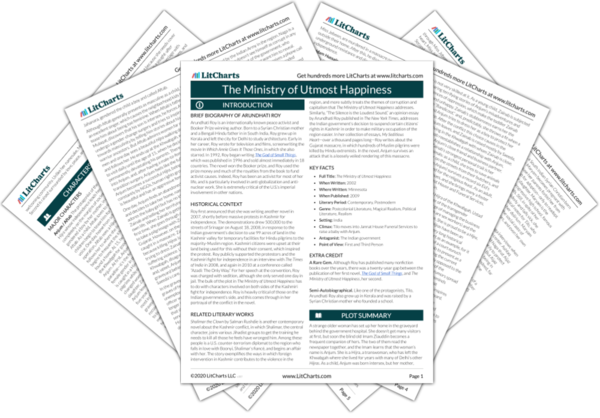The Ministry of Utmost Happiness addresses a wide range of issues facing contemporary Indian society. Among these various struggles, one of the most salient is religion: much of the violence that the characters observe and experience in the novel stems from conflicts between Hindus and Muslims. Roy demonstrates the ways in which religious extremism in both faiths leads to greater violence and intolerance in India. In doing so, she highlights the danger in allowing religious belief to seep into politics.
The first half of the novel contains many references to the rise of Hindu nationalism and violence that Muslims in mainland India suffered at the hands of Hindu extremists after the partition of Pakistan and India. When Anjum goes on a pilgrimage to a Muslim place of worship, she disappears because of Hindu extremist attacks. Allegedly, these attacks are in response to the burning of a train full of Hindus by “Pakistani terrorists.” In delivering this news, “a weaselly ‘unofficial spokesperson’ announces unofficially that every action would be met with an equal and opposite reaction.” Here, Roy’s emphasizes on the “unofficial” nature of this statement, which quite explicitly incentivizes the killing of Muslims as revenge for their supposed attack on the Hindus. To maintain the façade that the government is not officially advocating for the murder of Muslim citizens, the ruling party has an unofficial spokesperson say this. But the fact that anyone associated with the government would make such a statement in public is alarming, and demonstrates the extent to which Hindu nationalism has dangerously entered the mainstream politics of the country. Years later, Gujarat ka Lalla, a politician who was deeply involved with the Hindu nationalist movement, “swept the polls and was the new Prime Minister. People idolized him, and temples in which he was the presiding deity began to appear in small towns.” That Lalla’s political supporters would choose to celebrate his victory by placing him in the same position as a god demonstrates that, for them, politics and religion are almost inextricably intertwined. The blending of religion and government clearly allows for the continued violence against religious minorities in the country.
While on the whole Roy is far more critical of Hindu extremist government than she is of the Muslim resistance in Kashmir, she does clearly illustrate the ways in which extremist Islam serves only to divide communities from each other and further the violence in the region. One day in Kashmir, Usman Abdullah, “a prominent ideologue in the struggle for Azadi” is murdered by “the emerging hardline faction of militants” whom he openly opposed. Of an older generation, Abdullah was a university professor who believed in the “worshipping of home-grown saints and seers at local shrines” among other things offensive to the more radical Muslim groups that were claiming control of Kashmir. Here, what’s most clear is that the extremist beliefs of the new generation of militants led them to kill a member of their community, who supported their cause. It is evident that in espousing radical beliefs that lead to more and more factions among the Kashmiri community, the militants weaken their cause simply by reducing the number of people who willingly support and participate in the movement. While Kashmiris are united in their desire for freedom, even this the new generation of militants managed to make extremist: their interpretation of Azadi, the Kashmiri word for freedom, was “What does freedom mean? There is no God but Allah.” This interpretation of freedom clearly limits, in fact, the liberty of any citizens who would live under the rule of these militants, and sets the precedent for an intolerant Kashmir. Even if the militants were to win independence, with an ideology like this, the citizens would be likely to continue to experience at least some degree of religious conflict and violence.
Through portraying the extremism of religiously affiliated political leadership among Hindus and Muslims alike, Roy highlights the danger of lack of separation between church and state poses to citizen safety and liberty.
Religion and Power ThemeTracker

Religion and Power Quotes in The Ministry of Utmost Happiness
“The inbuilt idiocy, this idea of jihad, has seeped into Kashmir from Pakistan and Afghanistan. Now, twenty-five years down the line, I think, to our advantage, we have eight or nine versions of the ‘True’ Islam battling it out in Kashmir […] Some of the most radical among them […] are actually on our payroll. One of them was recently blown up outside his mosque by a bicycle bomb. He won’t be hard to replace. The only thing that keeps Kashmir from self-destructing like Pakistan and Afghanistan is good old petit bourgeois capitalism. For all their religiosity, Kashmiris are great businessmen. And all businessmen eventually, one way or another, have a stake in the status quo—or what we call the ‘Peace Process,’ which, by the way, is an entirely different kind of business opportunity from peace itself.”

Unlock explanations and citation info for this and every other The Ministry of Utmost Happiness quote.
Plus so much more...
Get LitCharts A+








